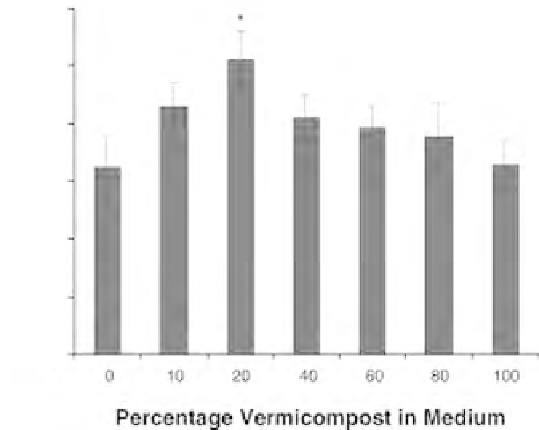Agriculture Reference
In-Depth Information
The growth of eggplants, dahlias, coleus, ornamental peppers, and polyanthus was also very
good in mixtures of vermicomposts with peat or other bulking material and was usually better than
in commercial plant growth media.
The effects of dilution with a commercial plant growth medium of vermicomposts on the growth
of three bush ornamentals at a range of levels of addition were quite dramatic (Scott 1988). When
a 50/50 mixture of pig and cattle vermicompost was diluted at a range of levels, ranging from 5
to 10%, with a commercial plant growth medium, all the mixtures, even at the lowest dilutions,
improved the growth of
Chaemaecyparis lawsoniana, Pyracantha
sp., and
Viburnum bodnantense,
even more than in the recommended commercial medium. Plants grown in all the dilutions and
different mixtures tended to grow better than those in the 100% vermicomposts, which had a
tendency to dry out more rapidly than the different mixtures. These results, for which even small
amounts of vermicomposts had significant effects on plant growth, indicated that the response could
not be based only on the nutrient content of the vermicomposts.
Vermicomposts were also used as ÑblockingÒ materials to grow seedlings for transplanting into
the field. Cabbages were grown in machine-compressed blocks made either from a commercial
seedling medium or from cattle and pig vermicomposts. The seedlings were transplanted into the
field in the same blocks, and their subsequent growth was followed and measured. Those seedlings
grown in blocks of vermicomposts produced cabbages almost twice as large at harvest than those
grown in the commercial blocking material (Edwards and Burrows 1988).
There is an increasing body of evidence from current work in the Soil Ecology Laboratory at
OSU that the substitution of vermicomposts into soilless bedding plant media (such as Metro-Mix
360) can increase the germination, growth, flowering, and fruiting of a wide range of greenhouse
vegetables and ornamentals, such as tomatoes (Figure 18.4) (Atiyeh et al. 1999, 2000d); peppers
(Arancon et al. 2004a); vegetable seedlings (Atiyeh et al. 2000a); marigolds (Atiyeh et al. 2000e,
2001); and other vegetables and ornamentals (Atiyeh et al. 2000b,c), and that amendments to field
crops with low application rates of vermicomposts can increase the growth of vegetables such as
peppers (Arancon et al. 2004b), fruits such as strawberries (Arancon et al. 2004c) and grapes
(Arancon et al. 2004g), and ornamentals such as petunias. All these increases in crop growth in
both greenhouse and field experiments were independent of nutrient supplies, which were equalized
6
5
4
3
2
1
0
0 10 20 40 60 80 100
Percentage vermicompost in medium
FIGURE 18.4
Marketable tomato fruit yields (mean ° SE) produced in standard commercial medium (Metro-
Mix 360) substituted with different concentrations of pig manure vermicompost. Columns with * are significantly
different from Metro-Mix 360 control (O% vermicompost) at
p
≤ .05 probability. (From Atiyeh et al. 2000. With
permission.)








































